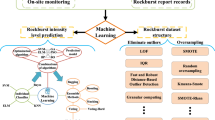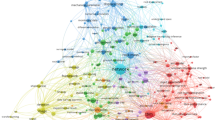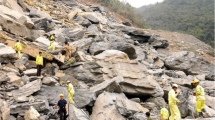Abstract
The rockburst hazard induced by the extreme release of the stress concentrated in rock mass in deep underground mines poses a significant threat to the safety and economy of the mining projects. Therefore, properly managing this hazard is critical for ensuring rock engineering projects’ sustainability. This study proposes comprehensible and practical classifiers for rockburst risk level appraisal by hybridizing K-means clustering with gene expression programming, GEP, logistic regression, LR, and classification and regression tree, CART (i.e., K-mean-GEP-LR and K-means-CART classifiers). A database containing 246 rockburst events with four risk levels of none, light, moderate, and severe was compiled from previous practices. Preliminary statistical analyses were conducted to detect the extreme outliers and determine the critical rockburst indicators. The K-means clustering analysis was performed to identify the main clusters within the database and relabel the rockburst events. The GEP algorithm was then utilized to develop binary models for predicting the occurrence of each class. Then, the likelihood of each class occurrence was determined using LR. Furthermore, the K-means clustering was combined with the CART algorithm to provide another visual tree structure model. The classifiers’ performance evaluation showed 96% and 95% accuracy values in the training and testing stages, respectively, for the K-means-GEP-LR model, while the accuracy values of 98.8% and 93.0% were obtained for the foregoing stages for the K-means-CART classifier. The results showed the robustness and high classification capability of both models. MatLab codes were also provided for the K-means-GEP-LR model, which assists other researchers/engineers in implementing the model in practice.












Similar content being viewed by others
Explore related subjects
Discover the latest articles, news and stories from top researchers in related subjects.Data availability
The datasets generated during and/or analyzed during the current study are available from the corresponding author on reasonable request.
References
Alavi AH, Hasni H, Lajnef N, Chatti K, Faridazar F (2016) Damage detection using self-powered wireless sensor data: an evolutionary approach. Measurement 82:254–283
Alkroosh I, Nikraz H (2012) Predicting axial capacity of driven piles in cohesive soils using intelligent computing. Eng Appl Artif Intell 25:618–627
Alzubaidi L, Zhang J, Humaidi AJ, Al-Dujaili A, Duan Y, Al-Shamma O, Santamaría J, Fadhel MA, Al-Amidie M, Farhan L (2021) Review of deep learning: concepts, CNN architectures, challenges, applications, future directions. J Big Data 8:1–74
Breiman L, Friedman JH, Olshen RA, Stone CJ (1984) Classification and regression trees. Cole statistics/probability series. Wadsworth & Brooks
Cabalar AF, Cevik A, Guzelbey IH (2010) Constitutive modeling of Leighton Buzzard Sands using genetic programming. Neural Comput Appl 19:657–665
Çanakcı H, Baykasoğlu A, Güllü H (2009) Prediction of compressive and tensile strength of Gaziantep basalt via networks and gene expression pamming. Neural Netw Appl 18:1031–1041
Chen K (2009) On coresets for k-median and k-means clustering in metric and euclidean spaces and their applications. SIAM J Comput 39:923–947
Çiftçi ON, Fadiloǧlu S, Göǧüş F, Güven A (2009) Genetic programming approach to predict a model acidolysis system. Eng Appl Artif Intell 22:759–766
Dancey CP, Reidy J (2017) Statistics without maths for psychology. Pearson, London
De’ath G, Fabricius KE (2000) Classification and regression trees: a powerful yet simple technique for ecological data analysis. Ecology 81(11):3178–3192
Faradonbeh RS, Armaghani DJ, Amnieh HB, Mohamad ET (2018) Prediction and minimization of blast-induced flyrock using gene expression programming and firefly algorithm. Neural Comput Appl 29:269–281
Faradonbeh RS, Hasanipanah M, Amnieh HB, Armaghani DJ, Monjezi M (2018) Development of GP and GEP models to estimate an environmental issue induced by blasting operation. Environ Monit Assess 190:1–15
Faradonbeh RS, Taheri A, e Sousa LR, Karakus M (2020) Rockburst assessment in deep geotechnical conditions using true-triaxial tests and data-driven approaches. Int J Rock Mech Min Sci 128:104279
Faradonbeh RS, Taheri A, Karakus M (2022) The propensity of the over-stressed rock masses to different failure mechanisms based on a hybrid probabilistic approach. Tunn Undergr Space Technol 119:104214
Farid DM, Zhang L, Rahman CM, Hossain MA, Strachan R (2014) Hybrid decision tree and naïve Bayes classifiers for multi-class classification tasks. Expert Syst Appl 41:1937–1946
Fawcett T (2006) An introduction to ROC analysis. Pattern Recognit Lett 27:861–874
Ferreira C (2006) Gene expression programming: mathematical modeling by an artificial intelligence. Springer
Ferreira C (2001) Gene expression programming: a new adaptive algorithm for solving problems. arXiv preprint cs/0102027
Ghasemi E, Gholizadeh H, Adoko AC (2020) Evaluation of rockburst occurrence and intensity in underground structures using decision tree approach. Eng Comput 36:213–225
Ghiringhelli LM, Vybiral J, Levchenko SV, Draxl C, Scheffler M (2015) Big data of materials science: critical role of the descriptor. Phys Rev Lett 114:105503
Giustolisi O, Doglioni A, Savic DA, Webb BW (2007) A multi-model approach to analysis of environmental phenomena. Environ Model Softw 22:674–682
Guo D, Chen H, Tang L, Chen Z, Samui P (2022) Assessment of rockburst risk using multivariate adaptive regression splines and deep forest model. Acta Geotech 17:1183–1205
Hasanipanah M, Faradonbeh RS, Amnieh HB, Armaghani DJ, Monjezi M (2017) Forecasting blast-induced ground vibration developing a CART model. Eng Comput 33:307–316
He M, Cheng T, Qiao Y, Li H (2022) A review of rockburst: experiments, theories, and simulations. J Rock Mech Geotech Eng 15(5):1312–1353
Hosseini S, Monjezi M, Bakhtavar E (2022) Minimization of blast-induced dust emission using gene-expression programming and grasshopper optimization algorithm: a smart mining solution based on blasting plan optimization. Clean Technol Environ Policy 24:2313–2328
Hoseinian FS, Faradonbeh RS, Abdollahzadeh A, Rezai B, Soltani-Mohammadi S (2017) Semi-autogenous mill power model development using gene expression programming. Powder Technol 308:61–69
Janusz A, Grzegorowski M, Michalak M, Wróbel Ł, Sikora M, Ślęzak D (2017) Predicting seismic events in coal mines based on underground sensor measurements. Eng Appl Artif Intell 64:83–94
Kaiser PK, Cai M (2012) Design of rock support system under rockburst condition. J Rock Mech Geotech Eng 4:215–227
Kaiser PK, McCreath DR, Tannant DD (1996) Canadian rockburst support handbook. Geomechanics Research Center
Ke B, Khandelwal M, Asteris PG, Skentou AD, Mamou A, Armaghani DJ (2021) Rock-burst occurrence prediction based on optimized Naïve Bayes models. IEEE Access 9:91347–91360
Keshavarz A, Mehramiri M (2015) New Gene Expression Programming models for normalized shear modulus and damping ratio of sands. Eng Appl Artif Intell 45:464–472
Khandelwal M, Armaghani DJ, Faradonbeh RS, Ranjith PG, Ghoraba S (2016) A new model based on gene expression programming to estimate air flow in a single rock joint. Environ Earth Sci 75:1–13
Khandelwal M, Armaghani DJ, Faradonbeh RS, Yellishetty M, Majid MZA, Monjezi M (2017) Classification and regression tree technique in estimating peak particle velocity caused by blasting. Eng Comput 33:45–53
Kodinariya TM, Makwana PR (2013) Review on determining number of cluster in K-Means clustering. Int J 1:90–95
Lee HB, Macqueen JB (1980) A K-Means cluster analysis computer program with cross-tabulations and next-nearest-neighbor analysis. Educ Psychol Measur 40:133–138
Li D, Liu Z, Armaghani DJ, Xiao P, Zhou J (2022) Novel ensemble tree solution for rockburst prediction using deep forest. Mathematics 10:787
Li D, Shirani Faradonbeh R, Lv A, Wang X, Roshan H (2022) A data-driven field-scale approach to estimate the permeability of fractured rocks. Int J Min Reclam Environ 36(10):671–687
Li N, Jimenez R (2018) A logistic regression classifier for long-term probabilistic prediction of rock burst hazard. Nat Hazards 90:197–215. https://doi.org/10.1007/S11069-017-3044-7/TABLES/12
Li X, Mao H, Li B, Xu N (2021) Dynamic early warning of rockburst using microseismic multi-parameters based on Bayesian network. Eng Sci Technol Int J 24:715–727
Liang M, Mohamad ET, Faradonbeh RS, Jahed Armaghani D, Ghoraba S (2016) Rock strength assessment based on regression tree technique. Eng Comput 32:343–354. https://doi.org/10.1007/S00366-015-0429-7/FIGURES/10
Liang W, Sari A, Zhao G, McKinnon SD, Wu H (2020) Short-term rockburst risk prediction using ensemble learning methods. Nat Hazards 104:1923–1946
Likas A, Vlassis N, Verbeek JJ (2003) The global k-means clustering algorithm. Pattern Recogn 36:451–461
Liu Z, Shao J, Xu W, Meng Y (2013) Prediction of rock burst classification using the technique of cloud models with attribution weight. Nat Hazards 68:549–568
Loh WY (2008) Classification and regression tree methods. Encycl Stat Qual Reliab 1:315–323
Luo H, Fang Y, Wang J, Wang Y, Liao H, Yu T, Yao Z (2023) Combined prediction of rockburst based on multiple factors and stacking ensemble algorithm. Undergr Space 13:241–261
Loozen G, Ozcelik O, Boon N, de Mol A, Schoen C, Quirynen M, Teughels W (2014) Inter-bacterial correlations in subgingival biofilms: a large-scale survey. J Clin Periodontol 41:1–10
Mercier D, Gaillard P, Aupetit M, Maillard C, Quach R, Muller JD (2006) How to help seismic analysts to verify the French seismic bulletin? Eng Appl Artif Intell 19:797–806. https://doi.org/10.1016/J.ENGAPPAI.2006.05.008
Papadopoulos D, Benardos A (2021) Enhancing machine learning algorithms to assess rock burst phenomena. Geotech Geol Eng 39:5787–5809
Pour AF, Faradonbeh RS, Gholampour A, Ngo TD (2023) Predicting ultimate condition and transition point on axial stress–strain curve of FRP-confined concrete using a meta-heuristic algorithm. Compos Struct 304:116387
Pu Y, Apel DB, Liu V, Mitri H (2019) Machine learning methods for rockburst prediction-state-of-the-art review. Int J Min Sci Technol 29:565–570
Pu Y, Apel DB, Xu H (2019) Rockburst prediction in kimberlite with unsupervised learning method and support vector classifier. Tunn Undergr Space Technol 90:12–18
Russenes BF (1974) Analysis of rock spalling for tunnels in steep valley sides. Norwegian Institute of Technology
Salimi A, Faradonbeh RS, Monjezi M, Moormann C (2018) TBM performance estimation using a classification and regression tree (CART) technique. Bull Eng Geol Env 77:429–440
Salimi A, Rostami J, Moormann C, Hassanpour J (2018) Examining feasibility of developing a rock mass classification for hard rock TBM application using non-linear regression, regression tree and genetic programming. Geotech Geol Eng 36:1145–1159
Sen S, Sezar EA, Gokceoglu C, Yagiz S (2012) On sampling strategies for small and continuous data with the modeling of genetic programming and adaptive neuro-fuzzy inference system. J Intel Fuzzy Syst 23:297–304
Shirani Faradonbeh R, Armaghani DJ, Monjezi M, Mohammad ET (2016) Genetic programming and gene expression programming for flyrock assessment due to mine blasting. Int J Rock Mech Min Sci 88:254–264
Shirani Faradonbeh R, Shaffiee Haghshenas S, Taheri A, Mikaeil R (2020) Application of self-organizing map and fuzzy c-mean techniques for rockburst clustering in deep underground projects. Neural Comput Appl 32:8545–8559
Shirani Faradonbeh R, Taheri A (2019) Long-term prediction of rockburst hazard in deep underground openings using three robust data mining techniques. Eng Comput 35:659–675
Shirani Faradonbeh R, Taheri A, Karakus M (2022) Fatigue failure characteristics of sandstone under different confining pressures. Rock Mech Rock Eng 55:1227–1252
Syakur MA, Khotimah BK, Rochman EMS, Satoto BD (2018) Integration k-means clustering method and elbow method for identification of the best customer profile cluster. In: IOP conference series: materials science and engineering. IOP Publishing, p 012017
Wu M, Ye Y, Wang Q, Hu N (2022) Development of rockburst research: a comprehensive review. Appl Sci 12:974
Wu S, Wu Z, Zhang C (2019) Rock burst prediction probability model based on case analysis. Tunn Undergr Space Technol 93:103069
Qiu Y, Zhou J (2023) Short-term rockburst damage assessment in burst-prone mines: an explainable XGBOOST hybrid model with SCSO algorithm. Rock Mech Rock Eng. https://doi.org/10.1007/s00603-023-03522-w
Yin X, Liu Q, Pan Y, Huang X, Wu J, Wang X (2021) Strength of stacking technique of ensemble learning in rockburst prediction with imbalanced data: comparison of eight single and ensemble models. Nat Resour Res 30:1795–1815
Yin X, Liu Q, Pan Y, Huang X (2021) A novel tree-based algorithm for real-time prediction of rockburst risk using field microseismic monitoring. Environ Earth Sci 80:1–19
Youn H, Gu Z (2010) Predicting Korean loading firm failures: an artificial neural network model along with a logistic regression model. Int J Hosp Manag 29:120–127
Zhang M (2022) Prediction of rockburst hazard based on particle swarm algorithm and neural network. Neural Comput Appl 34:2649–2659
Zhang Q, Barri K, Jiao P, Salehi H, Alavi AH (2021) Genetic programming in civil engineering: advent, applications and future trends. Artif Intell Rev 54:1863–1885
Zhang X, Nguyen H, Bui X-N, Tran Q-H, Nguyen D-A, Bui DT, Moayedi H (2020) Novel soft computing model for predicting blast-induced ground vibration in open-pit mines based on particle swarm optimization and XGBoost. Nat Resour Res 29:711–721
Zhao H, Chen B (2020) Data-driven model for rockburst prediction. Math Probl Eng. https://doi.org/10.1155/2020/5735496
Zhou J, Li X, Mitri HS (2018) Evaluation method of rockburst: state-of-the-art literature review. Tunn Undergr Space Technol 81:632–659
Zhou J, Li X, Mitri HS (2016) Classification of rockburst in underground projects: comparison of ten supervised learning methods. J Comput Civ Eng 30:04016003
Zhou J, Li X, Shi X (2012) Long-term prediction model of rockburst in underground openings using heuristic algorithms and support vector machines. Saf Sci 50:629–644
Zhou K, Gu D (2004) Application of GIS-based neural network with fuzzy self-organization to assessment of rockburst tendency. Chin J Rock Mech Eng 23:3093–3097
Acknowledgement
This study is also partly supported by The China University of Mining and Technology (CUMT).
Author information
Authors and Affiliations
Corresponding author
Ethics declarations
Conflict of interest
The authors declare that they have no known competing financial interests or personal relationships that could have appeared to influence the work reported in this paper.
Additional information
Publisher's Note
Springer Nature remains neutral with regard to jurisdictional claims in published maps and institutional affiliations.
Rights and permissions
Springer Nature or its licensor (e.g. a society or other partner) holds exclusive rights to this article under a publishing agreement with the author(s) or other rightsholder(s); author self-archiving of the accepted manuscript version of this article is solely governed by the terms of such publishing agreement and applicable law.
About this article
Cite this article
Shirani Faradonbeh, R., Vaisey, W., Sharifzadeh, M. et al. Hybridized intelligent multi-class classifiers for rockburst risk assessment in deep underground mines. Neural Comput & Applic 36, 1681–1698 (2024). https://doi.org/10.1007/s00521-023-09189-2
Received:
Accepted:
Published:
Issue Date:
DOI: https://doi.org/10.1007/s00521-023-09189-2




